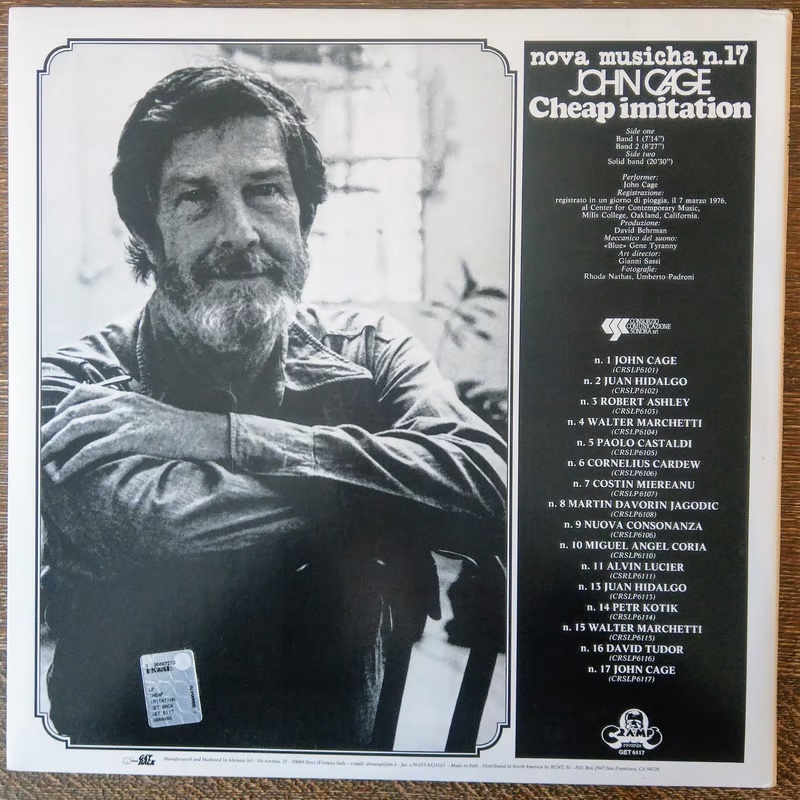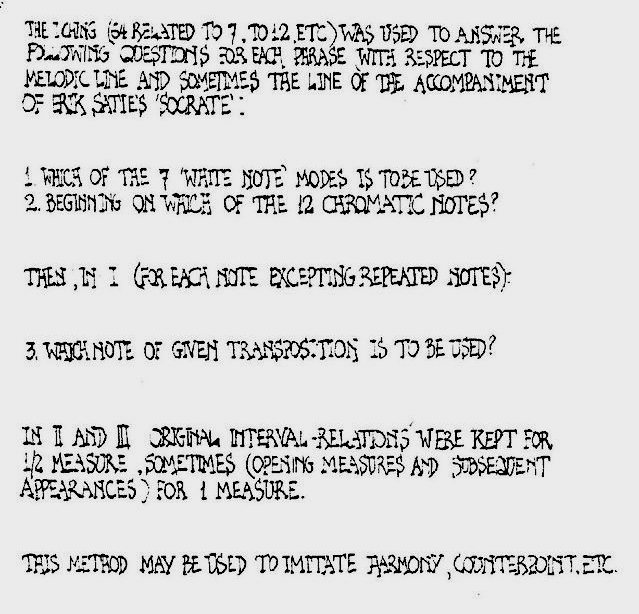
How did John Cage compose Cheap imitation? We are fortunate to have his own explanation of the system right in the front of the score:

Often Cage’s descriptions of his methods are not completely clear. They may assume some prior knowledge of other pieces and other systems. They may use language unfamiliar to someone not steeped in his way of working. They may be ambiguous. I’ll go through this description in detail and explain my own understanding of it. Later, I’ll explore examples from the score to make the system crystal clear, since Cage’s descriptions on their own are almost never enough to fully understand his methods.
Let me try to avoid one area of confusion that tripped me up. The way that Cage describes his process here acknowledges that he composed the first movement of Cheap imitation differently from the other two movements. But the way in which he presents this strongly suggests that he used a basic set of rules throughout the entire piece, one rule tweaked after the first movement. After more in-depth analysis, I discovered that this was not the case. In fact, the first movement uses a different set of rules than the other two. So in reading Cage’s account, we should consider it as a description of two different processes.
The I Ching (64 related to 7, to 12, etc.) was used to answer the following questions …
Cage used the I Ching or “Book of Changes” in almost every composition from 1951 onwards as a way of making decisions using chance. I won’t go into the details about how the I Ching works; the traditional methods typically used aren’t even relevant for Cage after about 1969, when he began using computerized simulations. What is essential about the I Ching for Cage’s compositional systems is that it generates random numbers between 1 and 64. When Cage used the I Ching to make a decision, the answer was always related to a number between 1 and 64. This doesn’t mean that there were always 64 possible answers. There might be only two: for example, whether, at a given point, there should be sound or silence. In this case, he might make the odds 50-50: an odd number means sound and an even number means silence.
Here, he mentions questions with 7 and 12 answers (the specifics of these to come soon). 64 cannot be evenly divided by these numbers, so there will be some bias towards one or more of the answers. Over the years, Cage handled this situation in different ways, and he doesn’t indicate which one is used here. In some cases, he would try to keep the outcomes as evenly distributed as possible. In others, he used methods that could produce outcomes radically skewed towards one or another answer. Since he doesn’t indicate which method he used here, my hunch is that this is a case where he kept the outcomes as even as possible. The uneven distribution of results usually requires extra steps that I think he would have mentioned.
... to answer the following questions for each phrase (with respect to the melodic line and sometimes the line of the accompaniment) of Erik Satie’s ‘Socrate’:
Cage defined his way of composing as the answering of questions. What he meant by this is that his way of working was methodical: algorithmic, we’d say today. His way of composing could be expressed in the form of a flow chart. But Cage wasn’t a mathematician or a computer scientist, and so he didn’t use this kind of language. Where I might think of his processes as a series of branching decision points, he thought of them as a series of questions. And the role of chance operations—of the I Ching—was to answer those questions. His compositional algorithm was driven by an ancient Chinese oracle (or, later, a computer simulation of an ancient Chinese oracle).
For Cheap imitation, Cage says here that his process involved making decisions about each phrase of the original Satie. That is, the process moved forward at the unit of the phrase. Cage indicates that he was using the “melodic line,” by which he means the vocal part. “The line of the accompaniment” is then the melodic line of the orchestra. Note that this is the one rule that does apply to all three movements.
Now Cage describes the rules for the first movement:
1. Which of the 7 ‘white note’ modes is to be used? 2. Beginning on which of the 12 chromatic notes?
These are the decisions made at the start of each phrase, using the random numbers that the I Ching method produces. The overall idea is that each phrase will be transposed to one of 84 different modes. By the “white note” modes, Cage means the seven modern modes: Ionian, Dorian, Phrygian, Lydian, Mixolydian, Aeolian, and Locrian. Each of these modal scales can begin on any of the 12 tones in our modern chromatic scale. This results in 84 possible modal transpositions for each phrase of the Satie. But Cage goes beyond just transposing each phrase …
Then, in I (for each note excepting repeated notes): 3. Which note of given transposition is to be used?
In the first movement, Cage randomly selected which of the seven notes of that mode was to be used for each tone of the Satie. In other words, he completely ignored the melody line of the original and generated a random (but still diatonic) melody line. The only exception here is for sequences of the same note within the phrase: once the rules determined the first note, the others follow the same.
Thus there are two levels at which Cage transformed the vocal line of the first movement of Socrate. At the phrase level, he transposed the music into different modes. And then at the note level within each phrase, he randomized the melody almost completely (save for the patterns of repeated notes).
Cage then describes the rules for the second and third movements:
In II and III original interval-relations were kept for ½ measure, sometimes (opening measures and subsequent appearances) for 1 measure.
The second and third movements use a different system that only required the answer to a single question. At the start of every phrase, and then again at every half-measure within that phrase, Cage asked: which of the twelve chromatic notes goes here? Starting from that note, he then preserved the original contour of Satie’s line until the next decision point. So where the first movement process resulted in a random modal melody, the process here preserves Satie’s melody, but randomly shifting it up or down in pitch every half-measure or so.
There’s one more exception here that Cage notes. Usually, he would randomly change the transposition of the vocal line every half a measure. But he says that he changed the frequency to a once a measure in “opening measures and subsequent appearances.” This is unclear: Opening measures of what? Subsequence appearances of what? Looking at the context, I believe it is certain that what he meant was the opening measures of the third movement—a very distinctive rising four-note scale motive—and all the other appearances of this motive. This is an example of a personal choice, something I’ll delve into later.
This method may be used to imitate harmony, counterpoint, etc.
Cage ends this explanation with a puzzling statement. Everything he has written to this point has been descriptive: he has listed the steps he took to compose Cheap imitation. This last statement, however, is suggestive. It says that the method described could be put to other (harmonic, contrapuntal) uses. By whom? By Cage? By the performer? And in what context? In the context of Cheap imitation? Or some completely different work? Cage says nothing further that could clarify the intent here.
Cage himself did go on to write more compositions that derived from other music. Some of these used the same method as Cheap imitation and had similar monophonic results. He composed a series of contrapuntal works that derived from early American four-part hymns, but these used a completely different method than Cheap imitation. They are not related to this suggestion written in the front of Cheap imitation. I am unaware of any “imitations” that Cage did of contrapuntal music. My best guess here is that Cage saw that this approach to composition had further possibilities and he just wanted to note that here. I might go so far as to say that he was excited by these possibilities; this instruction is a bit of over-sharing that comes from that enthusiasm.
This is how I interpret Cage’s description of his working method. But it is important to realize that Cage’s word on the matter is not the last one. He leaves out details of the process. How was the pedaling arrived at? The dynamics? The octave doubling? And Cage was not always the most reliable documentarian of his own work. I have always taken his descriptions as a starting point, but one that needs further validation and elaboration. How can we do this? Using Cage’s documentation as a framework, we can look at the resulting music, reverse-engineer the specific decisions that created it, and see if it all adds up.
This is part of the series Understanding Cheap Imitation
